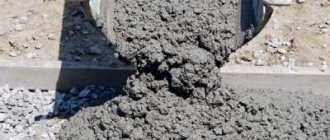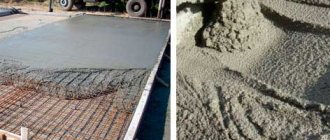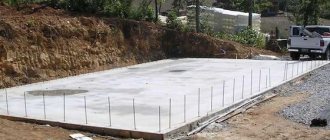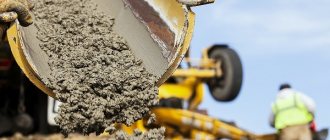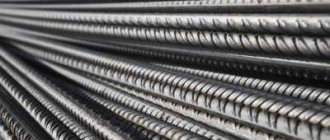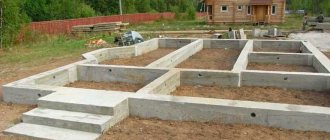The strip foundation is one of the most developed and studied types of supporting structures.
It is reliable, durable and capable of long-term service in any, even very difficult conditions.
At the same time, it is difficult to avoid mistakes without careful and professional calculations.
This especially applies to monolithic strips cast from reinforced concrete.
They are designed for the most difficult conditions and heavy loads, so it is necessary to exclude any possibility of miscalculations and errors that could cause irreparable damage.
To do this, first of all, you should have a sufficient understanding of the properties and parameters of the material used.
What brands and strength classes of concrete exist?
There are two quality indicators that characterize concrete:
- Class.
- Brand.
Concrete class means tensile strength in Megapascals.
Distinguish:
- Compressive strength class (denoted by Latin B).
- Axial tensile strength class (Bt).
Concrete class is a guaranteed strength value corresponding to GOST 26633-91. Depending on production conditions, technological features and other factors, the permissible error level is 13.5%.
There are classes from B3.5 to B80, but under normal conditions concrete with a class from B7.5 to B40 is used. This is due to the fact that extreme values are needed very rarely, low values are needed due to their weakness, and high values are used only on special structures and are redundant in normal construction.
The grade of concrete indicates the average strength value for a particular indicator. In construction practice, the brand is more often used, since the class value is not maintained by all manufacturers.
Taking into account the coefficient of variability, the quality of concrete of the same grade can belong to different classes that have close values to the real indicators of this material.
Which one is needed for private construction?
The brand is selected taking into account:
- soil quality,
- wall materials for the future home,
- its architectural features,
- number of storeys,
- purpose of the building (temporary building, summer cottage, year-round country house).
The heavier the building and the weaker the soil, the stronger the concrete should be. For areas with high underground flows, concrete with a high moisture resistance is needed.
Provided that the construction will be carried out on dense soil, you can select the material simply by number of floors and material in accordance with this table:
| Wall material | Concrete for a one-story building | Concrete for a two-story building |
| Brick or stone | IN 20 | B22.5 |
| Tree | B15 | B17.5 |
| Porous concrete | B17.5 | IN 20 |
Scope of application of various types
The scope of concrete is determined by its strength and resistance to external loads. The main criterion for the quality of a material is its ability to withstand pressure.
This indicator determines the area of use:
- Concrete grades from M5 to M35 are intended for filling voids in auxiliary elements or footings.
- M50-M100 are used for the preparatory layer before pouring concrete bases (the so-called footing).
- M150 is used for the manufacture of non-critical structures in low-rise construction.
- M200-M300 is the most common material in private or low-rise construction and is capable of solving most problems in this area. Used for foundations, wall structures and other elements.
- M400 is used for monolithic foundations of large multi-storey buildings, structural elements, floors, etc.
- M550 and higher grades are used for the manufacture of critical elements of special structures, used in the construction of subways, hydroelectric power stations, etc.
In private construction, the M200 and M250 brands predominate, the quality of which is quite sufficient to solve existing problems.
NOTE!
Brand is an old classification system inherited from Soviet times. Today's standards operate with the concept of “class,” but most builders have not yet adapted to the change in units of measurement, so the concept of “grade of concrete” is still relevant.
Classification of concrete solutions
First of all, what exactly is concrete? This term is usually understood as a stone of artificial origin, which is obtained as a result of hardening of a mixture poured into a mold, consisting of correctly selected components, which include:
— binder (most often cement plays this role);
— aggregates (usually sand, gravel or crushed stone, but some concretes require the use of other materials).
- water, which acts both as a diluent and as a necessary component for the chemical reaction of the formation and maturation of concrete stone.
Brands and strength classes of concrete
This is perhaps the main indicator that must be taken into account when choosing a specific solution.
The grade indicates what compressive load fully matured concrete can withstand, expressed in kgf/cm².
There are quite a few grades of concrete in terms of strength, from M50 to M800. However, in the field of private construction, and specifically when constructing foundations, developers, as a rule, will have to deal with grades from M100 to M300, less often - M400.
The grade of concrete indicates its ability to withstand compressive loads, expressed in kgf/cm²
In reference literature and in construction technological instructions, very often, instead of the concepts of brand strength, they operate with an indicator of the class of concrete. These quantities are, to a certain extent, interconnected, and differ, rather, in their “coordinate system”.
The class is denoted by the letter B and a numerical indicator that corresponds to the load (expressed in megaPascals), which with a 95% probability will be withstood by the prototype - a cube with sides of 150 mm.
However, in conditions of independent private construction, knowledge of such subtleties is unlikely to be needed. It is important to understand the grades of concrete and how they roughly relate to classes. The following table will help with this.
Table 1. Correlation between grades and classes of concrete
| Compressive strength of concrete, kg/cm2 | Concrete strength class | The closest concrete grade in terms of strength |
| 65.5 | AT 5 | M 75 |
| 98.2 | B 7.5 | M 100 |
| 131.0 | B 10 | M 150 |
| 163.7 | B 12.5 | M 150 |
| 196.5 | B 15 | M 200 |
| 261.9 | B 20 | M 250 |
| 294.4 | B 22.5 | M 300 |
| 327.4 | B 25 | M 350 |
| 392.9 | B 30 | M 400 |
| 458.4 | B 35 | M 450 |
Having such a “cheat sheet” at hand, it is easy to navigate both systems for assessing the strength of concrete.
Frost resistance of concrete
The frost resistance grade is designated by the letter symbol “F” and a number, which indicates the number of freezing and thawing cycles of material samples without any significant changes in its physical, mechanical and operational characteristics.
The method for determining frost resistance is established by GOST 10060.0-95. The same standard also provides for the classification of materials according to this indicator - markings vary from F25 to F1000.
When assessing frost resistance, unnecessary extremes are often taken:
Whatever concrete the foundation is poured from, its waterproofing is a must!
If we think sensibly, then the frost resistance class indicator in private construction is important only in two typical places where concrete products are used and there is no way to protect them from direct exposure to water.
Practice shows that for foundations (of course, with their waterproofing) the F150 indicator is quite sufficient, and for walls - even less, about F50÷F100
Cement prices
Concrete waterproof class
This indicator is indicated by the letter symbol W and a number (from W2 to W12). The numerical indicator indicates the maximum pressure, expressed in megaPascals, at which the prototype (cylinder 150 mm high) does not allow water to pass through.
Table 2. Approximate correspondence of concrete indicators with standard optimal combinations of components and compliance with the technology of mixing solutions
| Class (closest grade) of concrete by strength | Frost resistance | Waterproof |
| V-7.5 (M100) | F50 | W2 |
| V-12.5 (M150) | F50 | W2 |
| V-15 (M200) | F100 | W4 |
| V-20 (M250) | F100 | W4 |
| V-22.5 (M300) | F200 | W6 |
| V-25 (M350) | F200 | W8 |
| V-30 (M400) | F300 | W10 |
Indicators of workability of the solution
There are several criteria for assessing workability, but in everyday construction practice the most commonly used indicator is the workability indicator, denoted by the letter symbol P and a digital value. Where does everything come from?
Measuring how much the formed experimental mortar cone sank helps determine the mobility indicator of the finished concrete
The measured amount of subsidence of the cone from the initial horizontal level (from the top of the mold) will lead to the desired indicator of the mobility of the solution.
Table 3. Indicators of concrete mobility and features of the use of solutions
What requirements must it meet?
The main requirement for concrete is high strength and the ability to withstand external loads. The greatest forces acting on the belt are the weight of the building, the loads of frost heaving of the soil, acting on the sole (from bottom to top) and on the side surfaces.
The monolithic concrete strip must withstand all emerging loads and impacts, including the possibility of moisture saturation and freezing. Most of them manifest themselves in winter at low temperatures when interacting with groundwater.
The criterion is the predicted loads, taking into account the weight of the house, the effects of frost heaving, soil movement in the off-season, etc. The choice of material is made based on the totality of these indicators, which are subject to specialized calculations or determination using tables in the appendices of SNiP.
Useful tips and tricks
When choosing materials and components for the foundation of a building, pay attention to the following nuances:
- Even if the grade of concrete corresponds to high reliability, reinforcement will give the greatest strength to the structure, for which it is best to use corrugated reinforcement with a cross-section of at least 12 mm. In addition, this way you can compensate for ground movements.
- It is recommended to lay the strip foundation in one go, especially if we are talking about low grade concrete.
- If the weather is hot, then you should throw sawdust on the poured formwork or cover it with burlap.
- During the first week after pouring, it is recommended to water the hardening mixture several times a day.
Frost resistance
Frost resistance is an indicator characterizing the ability of a material to withstand a certain number of freezing-thawing cycles without changing its performance. It is designated by the letter F and has a range of values from 50 to 2000 cycles.
Frost resistance increases with increasing grade of concrete. For example, if concrete M250 has an F value of 100, then M350 has an F value of 200. At the same time, there is no direct relationship, which is due to the high coefficient of variability of the material.
This means that concrete of relatively weak grades can have high F values, but the probability of such a combination is very low. With a full guarantee, the expected F value can only be obtained with higher grades (or classes) of concrete.
Calculation of concrete for the foundation
The ratio of materials in different grades of concrete (cement M-400)
| Concrete grade | Material ratio (Cement x Sand x Crushed stone) | Cement consumption per 1m3 of concrete (kg) |
| M-100 | 1 x 4.6 x 7.0 | 170 |
| M-150 | 1 x 3.5 x 5.7 | 200 |
| M-200 | 1 x 2.8 x 4.8 | 240 |
| M-250 | 1 x 2.1 x 3.9 | 300 |
| M-300 | 1 x 1.9 x 3.7 | 320 |
How to calculate the load
The load on a strip foundation is calculated by adding up all the impacts on the strip.
Are taken into account:
- Self-weight of the base.
- The weight of the house, the total weight of the walls, ceilings, roof, structural elements, increased by a special coefficient (taking into account the weight of furniture, property and other interior items).
- Loads from the weight of snow in winter.
- Wind loads.
- Impact of frost heaving.
It is strongly not recommended to perform independent calculations of these impacts. Without experience in such calculations, errors are inevitable, the consequences of which can be fatal for the foundation or the entire structure.
It is necessary to contact a specialized organization and order a qualified calculation of the loads and load-bearing capacity of the belt.
IMPORTANT!
Alternatively, you can use an online calculator that is available on the Internet. They are able to provide fairly accurate data; this is usually sufficient for the construction of a private house. For greater reliability, you should duplicate the calculation on several calculators to protect yourself from miscalculations.
Types of concrete used in structural construction
Any construction project includes load-bearing and enclosing elements. Load-bearing structures include piles, beams, floor slabs, and trusses. That is, these are different elements that provide strength to the frame. They are made from heavy concrete in a factory or poured on site.
It is recommended to use slabs made of lightweight and cellular concrete as suspended structures. In low-rise construction, lightweight molded blocks are used to construct load-bearing walls.
Heavy structural concrete is a necessary component of any structure. Concrete artificial stone has the high strength of natural stone. It is formed from cement paste with inert fillers in the form of sand and crushed stone.
The block form is created in a factory or poured locally into prepared formwork. At the first moment of gaining strength, the structure needs maintenance. Products formed under reinforced concrete conditions meet the strength requirements and comply with GOST for products.
Which brand is suitable for the strip foundation of a private house?
The grade of concrete that best suits the existing conditions can be determined using the following criteria::
- Design load on the base.
- Qualitative indicators of the soil on the site, its type and composition.
- Depth of groundwater (GWL).
The main indicator is the load on the belt, the impact of soil and soil water - additional parameters that allow you to clarify and supplement the data obtained. It is noteworthy that detailed and detailed calculations are necessary for heavy and large buildings.
Private houses are predominantly lightweight and practically do not require too detailed calculations. In most cases, concrete grade M200 is used; for more difficult conditions, M250 or M300 is chosen.
The need to use heavier material arises extremely rarely, since the weight of a private house is not too large, and in the presence of very problematic soils, the solution to the problem is to change the foundation design from strip to pile-strip or pile-grillage.
It is not advisable to use concrete of stronger grades in these cases, since the soil pressure becomes too high and unstable, and relying on the strength of the tape becomes dangerous.
The ratio of components in the solution.
Before preparing concrete for the strip foundation of a house, you will have to study the required proportions of mixing crushed stone, sand and cement. The properties of the building mixture are affected by each of the listed ingredients that are included in its composition.
What brand of concrete is needed for a strip foundation.
The main binding component is cement, which forms a plastic mixture. After hardening, it becomes a strong monolithic structure, and the load-bearing capacity of the foundation of buildings depends on the strength indicator.
Thick concrete is considered the ideal option, however, it is difficult to achieve the desired consistency on your own. In industrial settings, vibrators are used to distribute the ingredients throughout the mixture.
Kawabanga! How to fill holes in a concrete wall
You can prepare concrete for a strip foundation when laying a house using a concrete mixer. You can achieve a thick consistency by tamping with a stick and a vibrator.
How ingredients affect the quality of concrete.
If suddenly the concrete cracks after pouring, the cracks must be repaired immediately with fresh mortar.
Brand of concrete for the strip foundation of a house.
Durable crushed stone plays an important role in the formation of a strip foundation. It needs to be selected only in a single large fraction of 20-25 mm so that the mixture is homogeneous.
Concrete proportions
The composition of concrete includes:
- Cement.
- Sand.
- Water.
- Filler (crushed stone of different fractions depending on the brand of concrete).
If it is necessary to produce concrete grade M200, per 1 m3 of material you will need:
- Cement M400 - 325 kg.
- Crushed stone - 1300 kg.
- Sand - 1300 kg.
- Water - 205 l.
For concrete M250:
- Cement M500 - 320 kg.
- Crushed stone - 1280 kg.
- Sand - 1280 kg.
- Water - 205 l.
Attention! The amount of crushed stone is indicated for a fraction of 10 mm. From different manufacturers, the composition of the material may vary slightly, which is due to different quality of the components.
Main components of homemade concrete mixture
If the mixture will be produced directly on the construction site on your own, you must adhere to the concrete manufacturing technology so that it obtains the necessary characteristics.
Cement
There are several types of cement suitable for making concrete for foundations:
- quick-hardening Portland cement;
- pozzolanic cement;
- Portland slag cement;
- Portland cement.
The most commonly used option is Portland cement. It is quite economical and has satisfactory properties. Other options are used for special requirements. Portland cement is purchased grade M400 or M500.
Sand
The sand must be homogeneous, without impurities and debris . It is better to use river sand - it is cleaner. An important parameter of sand is grain size.
When using M300 cement, you need to purchase fine sand with a particle size of about 2.5 mm. For a mixture based on stronger cement, coarser sand is needed - with a grain size of 3.5 mm or more.
Gravel or crushed stone
The base filler can be gravel or crushed stone . It is better to use gravel, as it has an optimal strength-to-price ratio. The size of the filler fractions depends on the dimensions of the foundation.
Large foundation strips are filled with concrete with a filler fraction of 10-20 mm. When arranging a shallow foundation, the gravel should be finer.
Water
Much depends on the quality of the water. It must meet the requirements of GOST. It should contain less than 5000 mg of salts per liter, no more than 2700 mg of sulfates, low acidity is needed.
You can use technical or drinking water . With an optimal salt composition, sea water is suitable. Sewage and swamp water cannot be used to create a foundation.
How to mix it correctly
Making concrete with your own hands is advisable only for small buildings with a shallow immersion depth of the tape and, accordingly, a small amount of material. The technology requires pouring the entire tape at one time, so for large bases it is better to order ready-made concrete delivered in a mixer directly to the site.
This option will allow you to avoid delays in pouring, which can be dangerous due to the appearance of poorly connected areas. A tape with such flaws will not be able to withstand operational loads.
If you decide to make concrete yourself, you will need to prepare all the necessary components and a concrete mixer. It is not necessary to purchase it; you can rent it for a couple of days.
You will need a sieve to sift sand, which may contain various clogging elements . In private construction, it is customary to use an armored mesh from a bed, which is installed obliquely above the receiving container.
Sand is thrown with a shovel through it into a container (box or trough), debris and foreign elements remain on the mesh. The best option is washed river sand without clay inclusions.
A gravity concrete mixer is capable of producing from 60 to 500 liters of solution per batch, depending on the volume. The volume must be known in order to be able to ensure the correct ratio of components.
The required amount of sand, crushed stone and cement is placed in a concrete mixer and mixed until a homogeneous mass is obtained, after which water is gradually poured in. Ready-made concrete is a plastic mixture with evenly distributed filler and the absence of lumps of sand or cement.
NOTE!
When mixing concrete in small batches, you should start laying with sand, to which cement is gradually added and then filler. This will allow the sand to be mixed with cement better and will eliminate lumps from the solution.
Additional markings
The letter “M” is usually indicated on the packaging of the mortar, but there is also a class “B”, which characterizes the level of strength that must correspond to “its” brand of concrete.
Strength factors influence the calculation of the ratio of sand, cement and crushed stone. Based on this, in order to build a strip concrete foundation, it is necessary to maintain certain proportions of the mixture components.
In addition, there is an “F” indicator, which determines the level of frost resistance. The number after the letter shows how many times the composition can freeze. Based on this, there is the following frost resistance range:
- F50 is the lowest degree.
- F50 – 150 is a normal degree of frost resistance, allowing concrete to withstand temperature changes for 100 years.
- F150 - 300 - an increased degree, which is suitable for more severe regions of the Russian Federation (for example, Western Siberia), where the soil freezes to a depth of more than 1.5 meters.
- F300 - 500 - used only if there is a threat of increased soil moisture with simultaneous freezing.
When determining what kind of concrete is needed for the construction of a strip foundation on the territory of the Russian Federation, it is best to choose a composition with a normal degree of frost resistance, for example, F150 - 200.
You can make the desired grade of concrete for a specific project on your own.
How to calculate quantity
Calculating the amount of concrete is necessary in order to stock up on all components in the required volumes. Experts recommend calculating each straight section of the tape separately and then summing up the obtained values.
In this case, it turns out that the corners are counted twice, but this is good, since it allows you to get a small supply of material.
The calculation begins with calculating the cross-sectional area of the tape. To do this, its height is multiplied by its width.
All calculations must be made in the same units, preferably in meters . Then the volume of material will be expressed in cubic meters, which allows you to simply and without errors calculate the number of components.
The cross-section of the tape is sequentially multiplied by the length of all straight sections of the tape, measured along the outer perimeter. Areas located under internal walls are calculated according to the length of the center lines.
The volumes of all sections are added up, the resulting value will represent the required amount of concrete with some margin.
Proportions for self-production of popular brands of cement
It is not at all necessary to buy ready-made, expensive solutions that do not always meet the stated characteristics. You can make the material according to the following recommendations:
- To get M 100, you need to mix 220 kg of cement, 0.8 m3 of crushed stone, 0.6 m3 of sand and 180 liters of water.
- For M 200 you will need 280 kg of cement, 0.8 m3 of crushed stone, 0.5 m3 of sand and 180 liters of water.
- M 250 will require 330 kg of cement, 0.5 cubic meters of crushed stone, 0.6 m3 of sand and 180 liters of water.
- For M 300, mix 380 kg of cement, 0.8 m3 of crushed stone, 0.45 m3 of sand and 180 liters of water.
To obtain a high-quality composition, the grade of Portland cement used must be 2 times higher than the grade of the finished composition. This means that if you want to get an output of M 200, then the Portland cement must be at least 400.
Healthy! It is worth remembering that if we are talking about obtaining a more durable grade (for example, M 300 or M 500), then the ratio of cement to the final mortar can be reduced to 1.5.
In addition, it is important to take into account the characteristics of the suburban area and the weight of the future building, as this will affect the calculation of the mixture.
Selection based on foundation type
The type of underground structure is also taken into account when choosing a concrete mixture:
- Concrete preparation: a mortar of grade M 100 is used. Permanent concrete formwork is also made from it - hollow blocks, into the cavity of which concrete is poured after installation.
- Ribbons. Grades from M200 to M400 are used.
- Plates. They are made of concrete grades not lower than M300.
- Columns and bored piles. The part immersed in the ground are separate pillars, which is why they are built from stronger concrete: not lower than M250, and better than M300 or M350. M200 concrete is suitable for the grillage.
Selecting a concrete mixer
The manual method of mixing concrete saves money, but is suitable for small volumes of work. A concrete mixer will allow you to prepare mixtures without much effort.
The mixer can be a rotating drum with an electric drive, or a bowl with a stirrer rotating inside. There is a tilting mechanism for easy removal of the mass.
The unit must be installed securely to prevent it from tipping over. There should be a free approach and space for ingredients.
Before starting work, the inside of the drum must be moistened with liquid cement mortar to prevent sticking.
Filling sequence when the drum is on:
- part of the sand;
- all cement;
- all crushed stone, remaining sand;
- fractional water.
Prolonged stirring is not required; the mass will begin to thicken. Unloading is carried out in one step, into a prepared tub. The cavity and mixer are immediately cleaned of adhering solution, and only then can the kneading be repeated.
Where to order fillers
Sand and gravel or crushed stone can be purchased at a hardware store or local quarry. You can save money by collecting coarse river sand, but then you need to dry it until it flows. All aggregates must be dry.
Application of additives
To ensure better plasticity and frost resistance of a homemade solution, you can use chemical additives, organomineral plasticizers. The use of additives will not improve the strength characteristics; they make it possible to prepare more technologically advanced mixtures with a minimum amount of water. They must be used in accordance with the instructions and safety precautions.
There are also folk methods that have been proven for centuries to improve the quality of concrete. When adding chicken eggs, the cement mortar gains plasticity and strength. Frost resistance increases with the addition of technical salt NaCl to the batch up to 2% by weight.
Lime
Often a small addition of dry quicklime serves as a plasticizer for concrete. But this component has another side - the strength of the structure is reduced.
Fluffy lime corrodes the skin and generates dust, so you need to wear safety glasses and rubber gloves when working. The additive makes the structure resistant to mold and mildew.
Component stacking sequence
Preparing cement paste manually is a labor-intensive and time-consuming process. It is necessary to mix as much solution as can be worked out before setting.
Ingredients prepared in the required proportions are collected in one place. Sand is poured into the bottom, then cement, and mixed until smooth. Crushed stone is added and thorough mixing is carried out again. The entire mixture is collected in a pile in a bath or on a sheet. Next, a hole is made in the middle, water is poured into it in a thin stream with continuous stirring. A homogeneous gray dough free of lumps is achieved.
Add the additives to the water, stir and make sure that the solution does not turn out liquid. Good consistency, when the ridge is formed on the surface, it does not settle.
The finished solution is spread over the formwork with compaction. Concreting is carried out continuously until the entire structure is filled.
